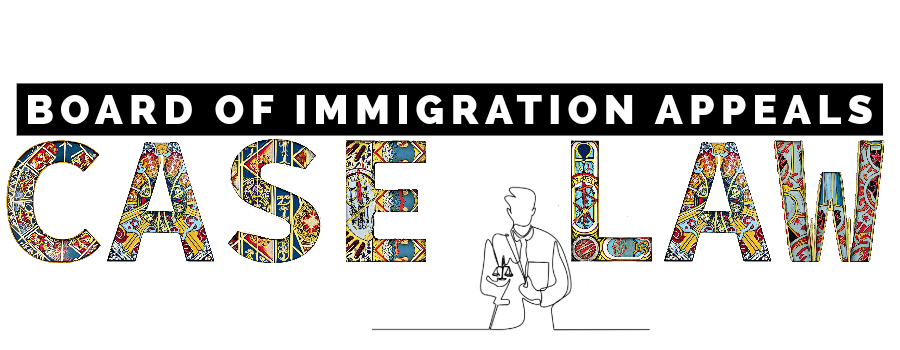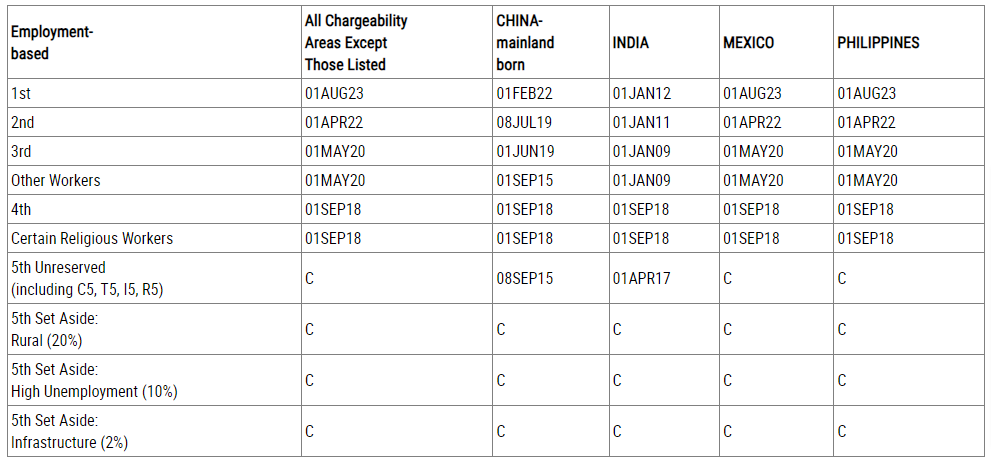The number of visas that are available for immigrants coming to the United States is limited under the law. The limitations are determined annually and then a monthly visa bulliten is published based on the number of visas used. The visa bulletin is used to determine when a visa is available. As an example this is the visa bulliten for September 2023. The Department of State has determined the Family and Employment preference numerical limits for FY-2023 in accordance with the terms of Section 201 of the INA. Under INA Section 202(a), the per-country limit is fixed at 7% of the family and employment annual limits. For FY-2023 the per-country limit is 29,616. The dependent area annual limit is 2%, or 8,462. These numerical limitations for FY-2023 are as follows: Worldwide Family-Sponsored preference limit: 226,000Worldwide Employment-Based preference limit: 197,091 STATUTORY NUMBERS FOR PREFERENCE IMMIGRANT VISAS This bulletin summarizes the availability of immigrant numbers during September for: “Final Action Dates” and “Dates for Filing Applications,” indicating when immigrant visa applicants should be notified to assemble and submit required documentation to the National Visa Center. Unless otherwise indicated on the U.S. Citizenship and Immigration Services (USCIS) website at www.uscis.gov/visabulletininfo, individuals seeking to file applications for adjustment of status with USCIS must use the “Final Action Dates” charts below for determining when they can file such applications. When USCIS determines that there are more immigrant visas available for the fiscal year than there are known applicants for such visas, USCIS will state on its website that applicants may instead use the “Dates for Filing Visa Applications” charts in this Bulletin. IMMEDIATE RELATIVES Immediate relative petitions are not subject to the family-sponsor preferences. Immediate relative visas are available once approved. Immediate relatives are considered to be: FAMILY-SPONSORED PREFERENCES All other family-sponsored visas are in preference categories. The preference categories will determine when the visa will become available. The family-sponsored preference categories are as follows: First: (F1) Unmarried Sons and Daughters of U.S. Citizens: 23,400 plus any numbers not required for fourth preference. Second: Spouses and Children, and Unmarried Sons and Daughters of Permanent Residents: 114,200, plus the number (if any) by which the worldwide family preference level exceeds 226,000, plus any unused first preference numbers: A. (F2A) Spouses and Children of Permanent Residents: 77% of the overall second preference limitation, of which 75% are exempt from the per-country limit; B. (F2B) Unmarried Sons and Daughters (21 years of age or older) of Permanent Residents: 23% of the overall second preference limitation. Third: (F3) Married Sons and Daughters of U.S. Citizens: 23,400, plus any numbers not required by first and second preferences. Fourth: (F4) Brothers and Sisters of Adult U.S. Citizens: 65,000, plus any numbers not required by first three preferences. September 2023 FINAL ACTION DATES FOR FAMILY-SPONSORED PREFERENCE CASES Family-Sponsored All Chargeability Areas ExceptThose Listed CHINA-mainland born INDIA MEXICO PHILIPPINES F1 01JAN15 01JAN15 01JAN15 22APR01 01MAR12 F2A 01JAN18 01JAN18 01JAN18 01SEP16 01JAN18 F2B 22SEP15 22SEP15 22SEP15 01AUG01 22OCT11 F3 08JAN09 08JAN09 08JAN09 15JAN98 08JUN02 F4 22APR07 22APR07 15SEP05 01AUG00 22AUG02 Visa Bulletin For September 2023https://travel.state.gov/content/travel/en/legal/visa-law0/visa-bulletin.html EMPLOYMENT-BASED PREFERENCES First: Priority Workers: 28.6% of the worldwide employment-based preference level, plus any numbers not required for fourth and fifth preferences. Second: Members of the Professions Holding Advanced Degrees or Persons of Exceptional Ability: 28.6% of the worldwide employment-based preference level, plus any numbers not required by first preference. Third: Skilled Workers, Professionals, and Other Workers: 28.6% of the worldwide level, plus any numbers not required by first and second preferences, not more than 10,000 of which to “*Other Workers”. Fourth: Certain Special Immigrants: 7.1% of the worldwide level. ***Special Immigrant Juvenile I-360 Petitions also use this preference category, read more. Fifth: Employment Creation: 7.1% of the worldwide level, of which 32% are reserved as follows: 20% reserved for qualified immigrants who invest in a rural area; 10% reserved for qualified immigrants who invest in a high unemployment area; and 2% reserved for qualified immigrants who invest in infrastructure projects. The remaining 68% are unreserved and are allotted for all other qualified immigrants. FINAL ACTION DATES FOR EMPLOYMENT-BASED PREFERENCE CASES Employment-based All Chargeability Areas ExceptThose Listed CHINA-mainland born INDIA MEXICO PHILIPPINES 1st 01AUG23 01FEB22 01JAN12 01AUG23 01AUG23 2nd 01JUL22 08JUL19 01JAN11 01JUL22 01JUL22 3rd 01MAY20 01SEP19 01JAN09 01MAY20 01MAY20 Other Workers 01MAY20 01SEP15 01JAN09 01MAY20 01MAY20 4th 01SEP18 01SEP18 01SEP18 01SEP18 01SEP18 Certain Religious Workers 01SEP18 01SEP18 01SEP18 01SEP18 01SEP18 5th Unreserved(including C5, T5, I5, R5) C 08SEP15 01APR17 C C 5th Set Aside:Rural (20%) C C C C C 5th Set Aside:High Unemployment (10%) C C C C C 5th Set Aside:Infrastructure (2%) C C C C C https://travel.state.gov/content/travel/en/legal/visa-law0/visa-bulletin.html DIVERSITY VISAS DIVERSITY IMMIGRANT (DV) CATEGORY FOR THE MONTH OF SEPTEMBER Section 203(c) of the INA provides up to 55,000 immigrant visas each fiscal year to permit additional immigration opportunities for persons from countries with low admissions during the previous five years. The NACARA stipulates that beginning with DV-99, and for as long as necessary, up to 5,000 of the 55,000 annually allocated diversity visas will be made available for use under the NACARA program. This will result in reduction of the DV-2023 annual limit to approximately 54,833. DV visas are divided among six geographic regions. No one country can receive more than seven percent of the available diversity visas in any one year. For September, immigrant numbers in the DV category are available to qualified DV-2023 applicants chargeable to all regions/eligible countries as follows. When an allocation cut-off number is shown, visas are available only for applicants with DV regional lottery rank numbers BELOW the specified allocation cut-off number: Region All DV Chargeability Areas ExceptThose Listed Separately AFRICA Current Except: Algeria 45,000 Egypt 43,200 Morocco 63,400 ASIA 21,000 Except: Iran 16,000 Nepal 21,000 EUROPE 32,000 Except: Russia 32,000 Uzbekistan 17,000 NORTH AMERICA (BAHAMAS) Current OCEANIA 2,500 SOUTH AMERICA,and the CARIBBEAN 3,150 https://travel.state.gov/content/travel/en/legal/visa-law0/visa-bulletin.html Entitlement to immigrant status in the … Read more



